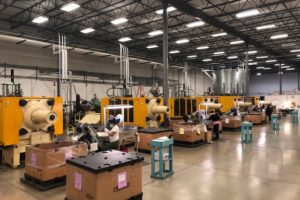Plastic molding processes offer a range of methods for creating intricate and durable plastic products. Among these processes, plastic injection molding stands out as a popular and versatile technique. However, there are other plastic molding methods, each with its own advantages and applications. This blog post will compare plastic injection molding to other prominent plastic molding processes, shedding light on their differences, strengths, and typical use cases. 
1. Plastic Injection Molding
Plastic injection molding is a highly versatile and widely-used process in the manufacturing industry. It involves injecting molten plastic material into a mold cavity under high pressure. The material then cools and solidifies, taking the shape of the mold. Key attributes of plastic injection molding include:
Precision and Complexity: It is capable of producing highly detailed and intricate parts with tight tolerances. This method is ideal for mass production, ensuring consistency and high-quality parts.
Material Variety: A wide range of thermoplastics and thermosetting plastics can be used, offering flexibility in material selection.
Applicability: From automotive components and medical devices to consumer goods and packaging, plastic injection molding finds applications across various industries.
2. Blow Molding
Blow molding is particularly suitable for hollow objects, such as bottles, containers, and tanks. The process involves inflating hot, molten plastic material into a mold cavity, giving it the desired shape. Key characteristics of blow molding include:
Hollow Structures: It excels in creating products with hollow interiors, owing to its ability to create seamless and lightweight containers.
Limited Complexity: While blow molding is excellent for simple shapes like bottles, it may be less suitable for intricate or highly detailed designs.
Applications: Commonly used in the packaging industry for items like plastic bottles and containers for various liquids.
3. Rotational Molding
Rotational molding is a process where powdered plastic material is placed in a mold and rotated in an oven, allowing the material to evenly coat the mold’s interior. Once cooled, the product is removed. Key features of rotational molding include:
Large, Seamless Parts: It is well-suited for creating large, seamless, and durable products such as storage tanks, playground equipment, and furniture.
Design Flexibility: Rotational molding allows for complex designs and the inclusion of multiple colors and textures in the final product.
Lower Tooling Costs: As the molds are generally less expensive, it can be cost-effective for producing lower volume parts or large, complex shapes.
4. Compression Molding
Compression molding involves placing a measured amount of plastic material directly into a heated mold cavity and applying pressure to create the final product. Key aspects of compression molding include:
Suitability for High-Strength Parts: It is often used for creating parts that require high strength and structural integrity.
Limited Complexity: Similar to other molding methods, the complexity of parts that can be produced is somewhat limited.
Applications: Commonly used for manufacturing products like appliance parts, electrical components, and automotive parts.
Comparative Analysis
Each plastic molding process has its unique strengths and applications. While injection molding excels in producing high-precision, intricate parts in high volumes across various industries, other methods like blow molding, rotational molding, and compression molding cater to specific needs. Blow molding is ideal for hollow structures, rotational molding for large and seamless products, and compression molding for high-strength components.
In sum up, the choice of plastic molding process largely depends on the specific requirements of the product in terms of complexity, volume, design, and material properties. Understanding the nuances and strengths of each method enables manufacturers to select the most suitable technique to meet their production needs and deliver high-quality plastic products.